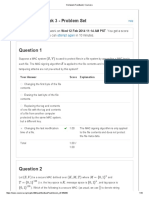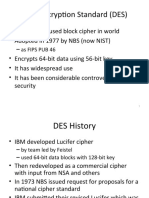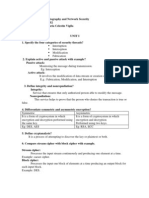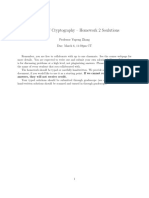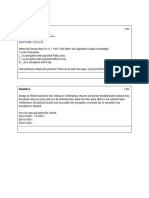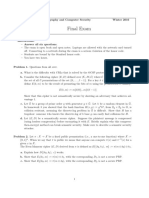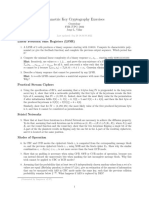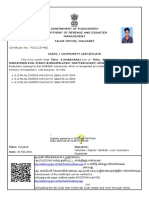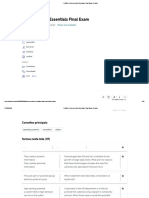11/28/2018 Cryptography I - Home | Coursera
Week 3 - Problem Set
Quiz, 10 questions
Congratulations! You passed! Next Item
1/1
point
1.
Suppose a MAC system (S, V ) is used to protect les in a le system
by appending a MAC tag to each le. The MAC signing algorithm S
is applied to the le contents and nothing else. What tampering attacks
are not prevented by this system?
Changing the last modi cation time of a le.
Correct
The MAC signing algorithm is only applied to the le contents and
does not protect the le meta data.
Replacing the contents of a le with the concatenation of two les
on the le system.
Changing the rst byte of the le contents.
Replacing the tag and contents of one le with the tag and contents of a le
from another computer protected by the same MAC system, but a di erent key.
1/1
point
2.
Let (S, V ) be a secure MAC de ned over (K, M , T ) where M = {0, 1}n and T = {0, 1}128 . That is, the key space is K , message space is {0, 1}n , and
tag space is {0, 1}128 .
Which of the following is a secure MAC: (as usual, we use ∥
∥ to denote string concatenation)
S ′ (k, m) = S(k, m ⊕ m) and
V ′ (k, m, t) = V (k, m ⊕ m, t)
Un-selected is correct
S ′ (k, m) = S(k, m[0, … , n − 2]∥
∥ 0) and
V ′ (k, m, t) = V (k, m[0, … , n − 2]∥
∥ 0, t)
Un-selected is correct
https://www.coursera.org/learn/crypto/exam/ECqUF/week-3-problem-set 1/9
�11/28/2018 Cryptography I - Home | Coursera
S (k, m) = S(k, m∥
′
∥ m) and
Week 3 - Problem Set
V ′ (k,Quiz,
m, t)10 questions ∥
= V (k, m∥ m, t).
Correct
a forger for (S ′ , V ′ ) gives a forger for (S, V ).
S ′ ((k1 , k2 ), m) = (S(k1 , m), S(k2 , m)) and
V ′ ((k1 , k2 ), m, (t1 , t2 )) = [V (k1 , m, t1 ) and V (k2 , m, t2 )]
(i.e., V ′ ((k1 , k2 ), m, (t1 , t2 )) outputs ``1'' if both t1 and t2 are valid tags)
Correct
a forger for (S ′ , V ′ ) gives a forger for (S, V ).
S ′ (k, m) = S(k, m) and
V ′ (k, m, t) = {
V (k, m, t) if m ≠ 0n
“1” otherwise
Un-selected is correct
S ′ (k, m) = [t ← S(k, m), output (t, t) ) and
V ′ (k, m, (t1 , t2 )) = {
V (k, m, t1 ) if t1 = t2
"0" otherwise
(i.e., V ′ (k, m, (t1 , t2 )) only outputs "1"
if t1 and t2 are equal and valid)
Correct
a forger for (S ′ , V ′ ) gives a forger for (S, V ).
1/1
point
3.
https://www.coursera.org/learn/crypto/exam/ECqUF/week-3-problem-set 2/9
�11/28/2018 Cryptography I - Home | Coursera
Recall that the ECBC-MAC uses a xed IV (in the lecture we simply set the IV to 0).
Week 3 - Problem Set
Suppose insteadQuiz,
we chose a random IV for every message being signed and include the IV in the tag. In other words, S(k, m)
10 questions := (r, ECBCr (k, m))
where ECBCr (k, m) refers to the ECBC function using r as
the IV. The veri cation algorithm V given key k , message m,
and tag (r, t) outputs ``1'' if t = ECBCr (k, m) and outputs
``0'' otherwise.
The resulting MAC system is insecure.
An attacker can query for the tag of the 1-block message m
and obtain the tag (r, t). He can then generate the following
existential forgery: (we assume that the underlying block cipher
operates on n-bit blocks)
The tag (r ⊕ m, t) is a valid tag for the 1-block message 0n .
Correct
The CBC chain initiated with the IV r ⊕ m and applied
to the message 0n will produce exactly the same output
as the CBC chain initiated with the IV r and applied to the
message m. Therefore, the tag (r ⊕ m, t) is a valid
existential forgery for the message 0.
The tag (r ⊕ t, r) is a valid tag for the 1-block message 0n .
The tag (m ⊕ t, r) is a valid tag for the 1-block message 0n .
The tag (r, t ⊕ r) is a valid tag for the 1-block message 0n .
1/1
point
4.
https://www.coursera.org/learn/crypto/exam/ECqUF/week-3-problem-set 3/9
�11/28/2018 Cryptography I - Home | Coursera
Suppose Alice is broadcasting packets to 6 recipients
Week 3 - Problem Set
B1 , … , B6 . Privacy
Quiz, is
10not important but integrity is.
questions
In other words, each of B1 , … , B6 should be assured that the
packets he is receiving were sent by Alice.
Alice decides to use a MAC. Suppose Alice and B1 , … , B6 all
share a secret key k . Alice computes a tag for every packet she
sends using key k . Each user Bi veri es the tag when
receiving the packet and drops the packet if the tag is invalid.
Alice notices that this scheme is insecure because user B1 can
use the key k to send packets with a valid tag to
users B2 , … , B6 and they will all be fooled into thinking
that these packets are from Alice.
Instead, Alice sets up a set of 4 secret keys S = {k1 , … , k4 }.
She gives each user Bi some subset Si ⊆S
of the keys. When Alice transmits a packet she appends 4 tags to it
by computing the tag with each of her 4 keys. When user Bi receives
a packet he accepts it as valid only if all tags corresponding
to his keys in Si are valid. For example, if user B1 is given keys {k1 , k2 } he will accept an incoming packet only if the rst and second tags are valid. Note
that B1 cannot validate the 3rd and 4th tags because he does not have k3 or k4 .
How should Alice assign keys to the 6 users so that no single user
can forge packets on behalf of Alice and fool some other user?
S1 = {k1 , k2 }, S2 = {k2 , k3 }, S3 = {k3 , k4 }, S4 = {k1 , k3 }, S5 = {k1 , k2 }, S6 = {k1 , k4 }
Un-selected is correct
S1 = {k1 , k2 }, S2 = {k1 }, S3 = {k1 , k4 }, §4 = {k2 , k3 }, S5 = {k2 , k4 }, S6 = {k3 , k4 }
Un-selected is correct
S1 = {k1 , k2 }, S2 = {k1 , k3 }, S3 = {k1 , k4 }, §4 = {k2 , k3 }, S5 = {k2 , k4 }, S6 = {k4 }
Un-selected is correct
S1 = {k2 , k4 }, S2 = {k2 , k3 }, S3 = {k3 , k4 }, S4 = {k1 , k3 }, S5 = {k1 , k2 }, S6 = {k1 , k4 }
Correct
Every user can only generate tags with the two keys he has.
Since no set Si is contained in another set Sj , no user i
can fool a user j into accepting a message sent by i.
https://www.coursera.org/learn/crypto/exam/ECqUF/week-3-problem-set 4/9
�11/28/2018 Cryptography I - Home | Coursera
1/1
point Week 3 - Problem Set
Quiz, 10 questions
5.
Consider the encrypted CBC MAC built from AES. Suppose we
compute the tag for a long message m comprising of n AES blocks.
Let m′ be the n-block message obtained from m by ipping the
last bit of m (i.e. if the last bit of m is b then the last bit
of m′ is b ⊕ 1). How many calls to AES would it take
to compute the tag for m′ from the tag for m and the MAC key? (in this question please ignore message padding and simply assume that the message
length is always a multiple of the AES block size)
Correct
You would decrypt the nal CBC MAC encryption step done using k2 ,
the decrypt the last CBC MAC encryption step done using k1 ,
ip the last bit of the result, and re-apply the two encryptions.
n+1
0/1
point
6.
Let H : M → T be a collision resistant hash function.
Which of the following is collision resistant:
(as usual, we use ∥ to denote string concatenation)
H ′ (m) = H(m∥
∥ m)
This should be selected
H ′ (m) = H(m)∥
∥ H(m)
Correct
a collision nder for H ′ gives a collision nder for H .
H ′ (m) = H(m) ⨁ H(m ⊕ 1∣m∣ )
(where m ⊕ 1∣m∣ is the complement of m)
Un-selected is correct
H ′ (m) = H(m∥
∥ 0)
https://www.coursera.org/learn/crypto/exam/ECqUF/week-3-problem-set 5/9
�11/28/2018 Cryptography I - Home | Coursera
Correct
nder Week 3 - Problem Set
′
a collision Quiz,for
10H gives a collision nder for H .
questions
H ′ (m) = H(m[0, … , ∣m∣ − 2])
(i.e. hash m without its last bit)
Un-selected is correct
H ′ (m) = H(0)
Un-selected is correct
H ′ (m) = H(m)[0, … , 31]
(i.e. output the rst 32 bits of the hash)
Un-selected is correct
1/1
point
7.
Suppose H1 and H2 are collision resistant
hash functions mapping inputs in a set M to {0, 1}256 .
Our goal is to show that the function H2 (H1 (m)) is also
collision resistant. We prove the contra-positive:
suppose H2 (H1 (⋅)) is not collision resistant, that is, we are
given x ≠ y such that H2 (H1 (x)) = H2 (H1 (y)).
We build a collision for either H1 or for H2 .
This will prove that if H1 and H2 are collision resistant
then so is H2 (H1 (⋅)). Which of the following must be true:
Either x, y are a collision for H1 or
x, y are a collision for H2 .
Either x, y are a collision for H1 or
H1 (x), H1 (y) are a collision for H2 .
Correct
If H2 (H1 (x)) = H2 (H1 (y)) then
either H1 (x) = H1 (y) and x ≠ y , thereby giving us
a collision on H1 . Or H1 (x) ≠ H1 (y) but
H2 (H1 (x)) = H2 (H1 (y)) giving us a collision on H2 .
Either way we obtain a collision on H1 or H2 as required.
https://www.coursera.org/learn/crypto/exam/ECqUF/week-3-problem-set 6/9
�11/28/2018 Cryptography I - Home | Coursera
Week 3 - Problem Set
Either x,Quiz,
y are a collision for H2
10 questions
or
H1 (x), H1 (y) are a collision for H1 .
Either H2 (x), H2 (y) are a collision for H1 or
x, y are a collision for H2 .
1/1
point
8.
In this question you are asked to nd a collision for the compression function:
f1 (x, y) = AES(y, x) ⨁ y ,
where AES(x, y) is the AES-128 encryption of y under key x.
Your goal is to nd two distinct pairs (x1 , y1 ) and (x2 , y2 ) such that f1 (x1 , y1 ) = f1 (x2 , y2 ).
Which of the following methods nds the required (x1 , y1 ) and (x2 , y2 )?
Choose x1 , y1 , y2 arbitrarily (with y1 ≠ y2 ) and let v := AES(y1 , x1 ).
Set x2 = AES −1 (y2 , v ⊕ y1 ⊕ y2 )
Correct
You got it !
Choose x1 , y1 , y2 arbitrarily (with y1 ≠ y2 ) and let v := AES(y1 , x1 ).
Set x2 = AES −1 (y2 , v ⊕ y2 )
Choose x1 , y1 , x2 arbitrarily (with x1 ≠ x2 ) and let v := AES(y1 , x1 ).
Set y2 = AES −1 (x2 , v ⊕ y1 ⊕ x2 )
Choose x1 , y1 , y2 arbitrarily (with y1 ≠ y2 ) and let v := AES(y1 , x1 ).
Set x2 = AES −1 (y2 , v ⊕ y1 )
1/1
point
9.
Repeat the previous question, but now to nd a collision for the compression function f2 (x, y) = AES(x, x) ⨁ y .
Which of the following methods nds the required (x1 , y1 ) and (x2 , y2 )?
Choose x1 , x2 , y1 arbitrarily (with x1 ≠ x2 ) and set
y2 = y1 ⊕ AES(x1 , x1 ) ⊕ AES(x2 , x2 )
Correct
Awesome!
Choose x1 , x2 , y1 arbitrarily (with x1 ≠ x2 ) and set
y2 = y1 ⊕ AES(x1 , x1 )
https://www.coursera.org/learn/crypto/exam/ECqUF/week-3-problem-set 7/9
�11/28/2018 Cryptography I - Home | Coursera
Choose Week
x1 , x2 , y13arbitrarily
- Problem (with x1Set
≠ x2 ) and set
Quiz, 10 questions
y2 = y1 ⊕ x1 ⊕ AES(x2 , x2 )
Choose x1 , x2 , y1 arbitrarily (with x1 ≠ x2 ) and set
y2 = AES(x1 , x1 ) ⊕ AES(x2 , x2 )
1/1
point
10.
Let H : M → T be a random hash function where ∣M ∣ ≫ ∣T ∣ (i.e. the size of M is much larger than the size of T ).
In lecture we showed
that nding a collision on H can be done with O(∣T ∣1/2 )
random samples of H . How many random samples would it take
until we obtain a three way collision, namely distinct strings x, y, z
in M such that H(x) = H(y) = H(z)?
O(∣T ∣2/3 )
Correct
An informal argument for this is as follows: suppose we
collect n random samples. The number of triples among the n
samples is n choose 3 which is O(n3 ). For a particular
triple x, y, z to be a 3-way collision we need H(x) = H(y)
and H(x) = H(z). Since each one of these two events happens
with probability 1/∣T ∣ (assuming H behaves like a random
function) the probability that a particular triple is a 3-way
collision is O(1/∣T ∣2 ). Using the union bound, the probability
that some triple is a 3-way collision is O(n3 /∣T ∣2 ) and since
we want this probability to be close to 1, the bound on n
follows.
O(∣T ∣3/4 )
O(∣T ∣)
O(∣T ∣1/4 )
https://www.coursera.org/learn/crypto/exam/ECqUF/week-3-problem-set 8/9
�11/28/2018 Cryptography I - Home | Coursera
Week 3 - Problem Set
Quiz, 10 questions
https://www.coursera.org/learn/crypto/exam/ECqUF/week-3-problem-set 9/9
